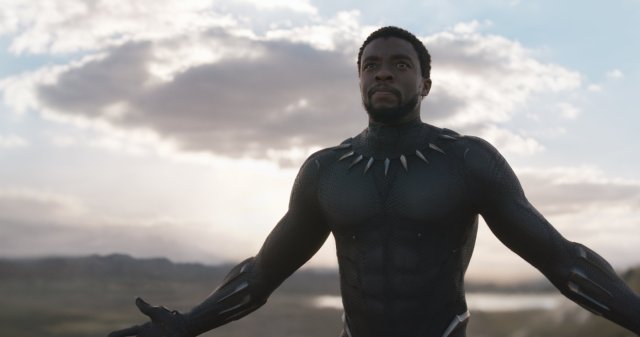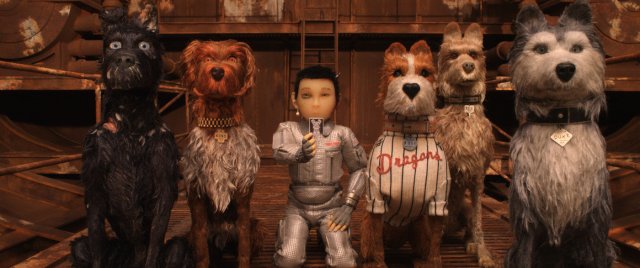By Alan Mattli
NOTE: This is a translation of my own article, originally published in German.
 What do Ryan Coogler’s Marvel blockbuster Black Panther and Wes Anderson’s stop-motion adventure Isle of Dogs have in common? Well, there’s the fact that both titles feature animals. Oh, and both are American films that, crucially, are set outside the United States. But the two most important similarities are about reception: not only are both movies among the year’s best so far; few other releases generated as much discussion in the media. You’d think that this fact, along with my opinion of the two films, would be more than cogent reasons for me to review them.
What do Ryan Coogler’s Marvel blockbuster Black Panther and Wes Anderson’s stop-motion adventure Isle of Dogs have in common? Well, there’s the fact that both titles feature animals. Oh, and both are American films that, crucially, are set outside the United States. But the two most important similarities are about reception: not only are both movies among the year’s best so far; few other releases generated as much discussion in the media. You’d think that this fact, along with my opinion of the two films, would be more than cogent reasons for me to review them.
However, since February, when I saw both works for the first – and not the last – time, I’ve been putting off writing about them, even though I’m less than enthusiastic about the thought of letting two five-star movies pass me by without comment. The reason for this is not a lack of intriguing talking points or stylistic choices but the knowledge of not being able to add anything meaningful to the existing discourse.
 Both films have, for different reasons, inspired a lot of authors (see below) to write excellent pieces, whose arguments and conclusions have, naturally, also influenced my thoughts about and my understanding of what I first had the pleasure to see in February. Thus, I don’t think I would be able to deliver an exclusive, original take based on my own observations anymore.
Both films have, for different reasons, inspired a lot of authors (see below) to write excellent pieces, whose arguments and conclusions have, naturally, also influenced my thoughts about and my understanding of what I first had the pleasure to see in February. Thus, I don’t think I would be able to deliver an exclusive, original take based on my own observations anymore.
But that’s just half the story. Black Panther and Isle of Dogs – or at least the debates surrounding them – exemplify an emerging truth with which the white and male-dominated world of film criticism, like society at large, still has to come to terms with: not everything can be authoritatively discussed by everyone. As Film Crit Hulk put it in his essential essay “On Criticism in the Intersectional Age” last year, “This is about what you’ve been saying and the ways I’m finally listening and getting out of the way.”
In practical terms, this means that while the two movies at hand demand detailed critical analysis, I am not the most suitable critic for the task. Coogler’s Black Panther is about the titular black superhero (played by Chadwick Boseman), who is crowned king in his fictional native country – the uncolonised, technologically advanced African kingdom of Wakanda – and whose rule is challenged by an African-American mercenary calling himself “Killmonger” (Michael B. Jordan). Anderson’s Isle of Dogs, meanwhile, is set in a dystopian Japanese metropolis where all dogs are deported to an island made of trash. The film drew criticism for its usage of Japanese culture and language as decorative elements.
I’m not the right person to lecture others about the importance of Black Panther – its mainly black cast, its strong, well-rounded female characters, its box-office success, its intelligent, nuanced take on the consequences of diaspora. My voice carries little weight in a debate over whether and how Wes Anderson is guilty of cultural appropriation in Isle of Dogs – and what this means for the film’s attempt to make a point about the treatment of refugees at the hands of Western countries, a motif already present in Anderson’s previous feature, 2014’s The Grand Budapest Hotel.

The most productive thing I can do in this discourse is to learn from others’ perspectives. That’s why this article will be neither an extensive review nor a close reading. Rather, it’s supposed to serve as a signal-boosting directory pointing you in the direction of those who have tackled and assessed the questions the two films raise in a substantiated way – and whose thoughts have informed my own comprehension and appreciation of these wonderful works.
For Black Panther – so far the best entry into the “Marvel Cinematic Universe,” in my opinion – the Film Crit Hulk essay “Black Panther‘s Right Thing” is a good point of entry, especially in the context of my own article. Hulk is in the same situation as myself and countless other critics, and he makes that acknowledgment a cornerstone of his piece: “What I’m hopefully trying to put forth in this essay is not the product of some white guy explaining how racism works to people who have far more personal understanding, but just a reflection of that same listening. And the willingness to be wrong within this conversation about literally everything I’m putting forth.”
Following this, I recommend a trio of articles – the best I’ve had the pleasure to read on the topic of Ryan Coogler’s film: “The Provocation and Power of Black Panther” by Vann R. Newkirk II, “The Tragedy of Erik Killmonger” by Adam Serwer, and “Black Panther and the Invention of ‘Africa'” by Jelani Cobb. All three mainly (but not exclusively) read the movie through the postcolonial diaspora lens, exploring how Coogler and co-writer Joe Robert Cole elegantly incorporate the lasting dual shadow of colonialism and the transatlantic slave trade into a franchise blockbuster structure and how, on top of that, they address it in an emotionally resonant way.

If you prefer lively conversation to written film analysis, I recommend paying a visit to the Facebook page of Zurich’s Zentrum Künste und Kulturtheorie. There you can find a 90-minute recording of a panel discussion in which Danielle Dash, Musa Okwonga, Franziska Meister, and Simon Küffer adroitly, and often humorously, debate both the film’s merits as well as its problematic aspects.
I don’t feel capable of adding anything worthwhile to this abundance of inspiring and illuminating material, so I think I can, in good conscience, leave it at an unequivocal endorsement: Black Panther is a breathtaking, visually stunning, thematically astute, perceptively contemporary cinematic spectacle.
It gets a bit more complicated with Isle of Dogs, as the articles dedicated to it are the result of attempting to highlight a potential problem – and not, as is the case with Black Panther, of widespread admiration. Few will deny the well-known artistic mastery of Wes Anderson and his animation team. Their creation is of immense beauty, both aesthetically and emotionally.

Isle of Dogs is teeming with childlike imagination and wonder, movingly captured love for pets, loveably eccentric wit, and romantic melancholy. It truly is an Anderson special, with characters populating a gorgeously designed, remarkably detailed, handmade world where everything has its place – but which is still teetering on the brink of chaos.
The debate surrounding the film stems from its use of Japan as a setting and its depiction and treatment of Japanese characters. While the protagonists, a pack of dogs, all speak English – in the famous voices of Bryan Cranston, Bill Murray, Edward Norton, and Jeff Goldblum, among others – the people in Isle of Dogs, apart from an American exchange student (Greta Gerwig) and an interpreter (Frances McDormand), only speak Japanese, which is often not translated directly and never subtitled.
This staging of the Japanese language as well as Anderson’s dreamy vision of Japan in general are the subject of a fascinating debate that has been going on in film media for a few months now. And again, this is where my powers of judgement hit a brick wall: as a white Western European, I am simply not equipped to make a relevant contribution to a conversation that is primarily about Japanese people and Japanese-Americans and their representation in U.S. popular culture.
This is also about seeing minority groups not as a unified front but as a heterogenous collection of complex individuals. This comes to the fore, for example, in Emiy Yoshida’s excellent article, in which she outlines her qualms about Isle of Dogs‘ Japanese elements but also admits to not being fluent enough in her parents’ mother tongue to make conclusive judgements on the Japanese dialogue.

Slightly less forgiving takes, which are just as thoughtful and just as worth reading as Yoshida’s, come from Justin Chang and Angie Han, who detect a subconscious marginalisation of the Japanese characters taking place in Isle of Dogs. They are in turn contradicted by Japanese emigrant Moeko Fujii, who reads the film’s unsubtitled portions as a space to which Japanese-speaking audiences enjoy privileged access (“I was hearing voices from home”) and as a comment on the fundamental imperfection of any translation.
As someone who loves Anderson’s latest, I gravitate towards Fujii’s assessment almost by default, yet I have to keep in mind that I am in no position to ascribe more validity to her piece than to ones by Yoshida, Chang, and Han. If I were to review Isle of Dogs, I wouldn’t be able to ignore the ongoing discussion about authenticity and representation – but I would also be unable to adequately address it.
So I’m going to put an end to this – ironically still pretty lengthy – explanation why I didn’t and won’t review either Black Panther or Isle of Dogs in the usual manner. Instead, I’d like to thank Film Crit Hulk, Vann R. Newkirk II, Adam Serwer, Jelani Cobb, Emily Yoshida, Justin Chang, Angie Han, and Moeko Fujii for their work. I encourage everyone to read their pieces and follow them on Twitter. It’s a good place to listen.
Black Panther – ★★★★★
Isle of Dogs – ★★★★★
–––––
For more film commentary from Alan, visit facingthebittertruth.com.
